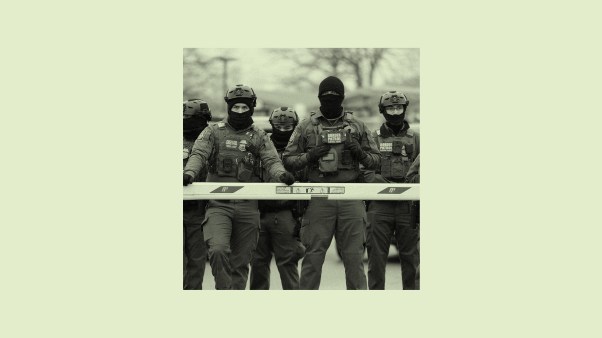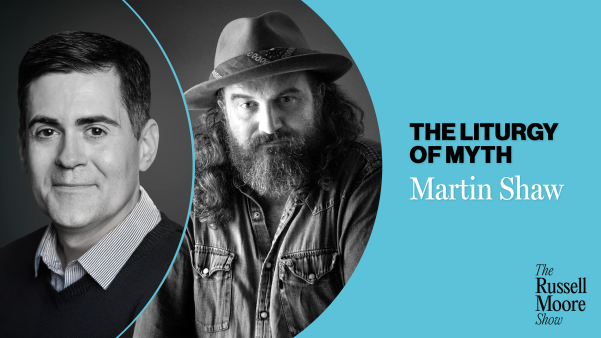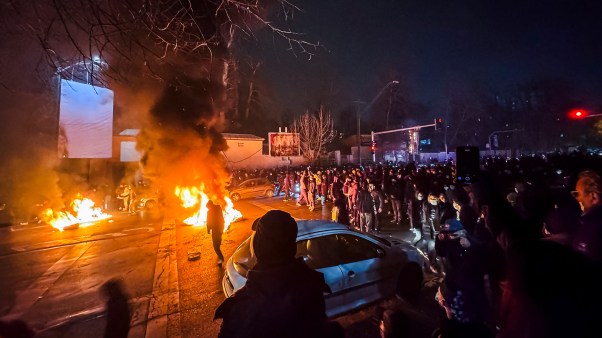In East Palestine, Ohio, days after last year’s train crash and subsequent burning of more than 100,000 gallons of toxic chemicals, 14-year-old Jameson Kenneally noticed that his family’s chickens were producing wrinkled eggs. They live three miles from where the chemicals ignited. His mom, Jamie Kenneally, explained to him that the eggs could be wrinkled for a variety of reasons. Maybe it wasn’t the chemicals. After all, their chickens had been through a stressful experience.
On February 3, 2023, a Norfolk Southern train derailed just outside of town, near the Pennsylvania border. Twenty cars carrying hazardous chemicals—vinyl chloride (the most alarming), ethylene glycol, ethylhexyl acrylate, butyl acrylate, and isobutylene—caught fire and spilled into a nearby stream. The chemicals were heading from Texas to a plastics factory in New Jersey, according to The New York Times, a journey of around 1,600 miles. That meant what happened in East Palestine could have happened anywhere.
After the chemical fire burned for three days, local officials decided to drain and detonate the remaining substances in a “controlled release” to prevent a larger explosion. A flurry of police went door to door in the town of 5,000, telling people to leave, and the Kenneally family evacuated.
At first they slept in the youth room of Bethel Evangelical Presbyterian Church in nearby Enon Valley, Pennsylvania, where Jamie’s husband, Steve Kenneally, is a pastor. Eventually, they retrieved their chickens and relocated with them to a friend’s house, after police announced that it might be days before they could return home.
The burn-off created a chemical cloud that was visible for miles—an indelible memory for residents who evacuated against a backdrop of towering flames and smoke. When I visited East Palestine, seven months after the derailment, people pulled up pictures on their phones, ready to show me the inferno from that night.
It’s a beautiful town on the edge of Appalachia, not far from the Rust Belt cities of Youngstown and Pittsburgh. Surrounded by rolling hills and farms, East Palestine’s downtown is densely built. The train tracks run right through the middle, with homes on both sides. Everyone’s thankful the derailment happened on the east side of town instead of there, where it could have killed people.
The fire coated the Kenneallys’ windshield in some kind of residue, which meant everything on their property must have been coated. So they got their well tested. The test found no detectable contaminants, but they weren’t sure if they had even tested for the right chemicals—at the time, people in East Palestine didn’t know what chemicals were on the train or what other compounds had been released by the burn. They weren’t sure of anything. The Kenneallys bought a water filtration system and air purifiers for extra peace of mind.
Uncertainty was a theme over and over in my interviews with East Palestine residents in fall 2023. No one knew what exactly had happened to their town. Was the water safe? Were officials lying to them? Were neighbors faking symptoms to get payouts from the railroad company? If they wanted to leave, could they sell their homes? If they stayed, would they get cancer? Could their children play in the park? Was it all overblown?
Disasters often bring a community together. But in East Palestine—a place where families go back generations—the opposite is happening. All the unknowns have divided neighbor against neighbor, churchgoer against churchgoer, husband against wife.
Community conflict was the first thing anyone brought up with me about the derailment. In a local store, one woman told me bluntly that anyone still anxious about the crash could just move. Some residents didn’t want to be interviewed for fear of being seen as on one side (“Everything is fine”) or the other (“Our town is ruined”) of the social divide. Conflict spilled into—or perhaps was encouraged by—comments on social media. When a news story appeared on Facebook announcing that testing for a particular chemical was no longer necessary, someone posted, “Everybody can be totally hooray for this good news!” Someone else responded, “Bulls—.”
In the months after the crash, it was unclear for many whether life could or even should return to normal. Trains had resumed running through town five days after the derailment, and at times they barreled past roughly every 15 minutes. Some people were going about their ordinary lives, clocking in at work or attending high school football games. Others couldn’t return to their homes in town without nausea, headaches, and sore throats.
Were they imagining it?
Relationships were strained over disagreements over such questions, because East Palestine was in a knowledge crisis. Foreign actors even contributed: Russian social media accounts parroting Kremlin talking points circulated ideas that US officials were hiding the impact of the crash and that the government was giving aid to Ukraine but not Ohioans. The head of the Federal Emergency Management Agency, Deanne Criswell, said that the spread of misinformation after disasters like East Palestine is a “new threat landscape. … Our adversaries know when we are most vulnerable and know how to take advantage of those times.”
If a knowledge crisis could devastate relationships in a close-knit community like East Palestine, the kind of place where locals can reel off the name of every business owner in town, what could it do elsewhere in the United States?
When I was in town, trucks were constantly rolling in and out, bringing cleanup equipment or carting away contaminated soil. By that point, Norfolk Southern had removed more than 88,000 tons of hazardous waste and collected 28 million gallons of hazardous water from above and below ground. The company estimates that it has spent about When I was in town, trucks were constantly rolling in and out, bringing cleanup equipment or carting away contaminated soil. By that point, Norfolk Southern had removed more than 88,000 tons of hazardous waste and collected 28 million gallons of hazardous water from above and below ground. The company estimates that it has spent about $1 billion on the cleanup so far. billion on the cleanup so far.
Less than a month after the derailment, Ohio declared the tap water safe and the Environmental Protection Agency (EPA) said it wasn’t finding contaminants in homes. But many residents could not shake the uneasy sense that they were still living in a disaster zone.
At the time I visited, Norfolk Southern had a secure perimeter around the cleanup area, and a key local road remained closed. Small things became points of tension, like whether one’s children played in the town park. One of the cleanup sites was a contaminated creek that ran through the park. Some parents kept their children away; Jameson Kenneally didn’t compete in his usual tennis season there because the park courts were close to the creek. But other parents made a point to take their children to the park to indicate that everything was fine—to show that the town was “East Palestine Strong,” as some yard signs read.
Local businesses struggled after the derailment. Some business owners told reporters they were treated like villains simply for marketing themselves and trying to draw customers back to East Palestine. Meanwhile, there were constant meetings about the derailment: city council meetings, meetings with lawyers, meetings with the railroad, cable news town halls. And in a place where the COVID-19 pandemic had already fostered distrust of government officials, suspicion of authorities compounded the inability to fully understand the disaster.
So those meetings sometimes boiled over. When Ohio’s top health official, Bruce Vanderhoff, met with residents soon after the derailment to discuss what, besides the derailment, might be causing health symptoms, they rebuffed him. “I don’t know what to do to provide further assurances,” he responded, according to The Independent. During a visit that same day, EPA administrator Michael Regan insisted that everything was fine: “If we say that the water is safe and the air is safe, we believe it, because we’ve tested it and the data shows it.” A local farmer suggested Regan drink the tap water himself if he was so sure. (Regan did have a glass.)
Months later, the striving for information was still everywhere in town. Vans drove the streets testing the air. Residents received fliers from various universities conducting studies. The EPA sent regular newsletters.
Many residents took precautions—culling their chickens, not gardening for the year—and carried on. But months later, some people in town could still smell chemicals. Some had headaches or nausea, and their children had regular nosebleeds. Symptoms raised questions: Is that rash because of the derailment?
 Illustration by Israel G. Vargas
Illustration by Israel G. VargasSome people in town told me they felt overwhelmed by anxiety. Some felt they had to choose between financial ruin (by abandoning homes they could not sell) and getting cancer in 20 years (since vinyl chloride exposure is associated with several cancers).
Even where there was information, it sometimes didn’t seem like enough.
Contaminated water killed about 44,000 wild animals around East Palestine, according to Ohio officials, including small fish, crayfish, amphibians, and macroinvertebrates. When a local fox keeper reported that some of his foxes died suddenly after the derailment, however, who could be certain if it was vinyl chloride poisoning or something else?
“You didn’t know who to believe,” said Jamie Kenneally. “I want to love and serve, but there’s so much information.” She was just one person raising children and chickens, trying to sort through conflicting accounts from neighbors, on social media, and in the news and trying to feel trust in the people around her.
East Palestine is a place where everyone expects to know everyone else. There is general political agreement: 72 percent of surrounding Columbiana County voted for former president Donald Trump in 2016.
But being in decades-long relationships and living among like-minded people didn’t save East Palestine from division when the train crashed. The knowledge crisis piled a relational disaster on top of a chemical one.
Misti Allison, a congregant at First Church of Christ, the largest church in town with about 200 people, said she knows marriages that broke up because of disagreements about the derailment. Others said the same.
Fritz Nelson, the pastor of First United Presbyterian Church in East Palestine, has parishioners who lived across the street from the derailment. He went to check on them at their homes the day after the evacuation order was lifted. They didn’t clean anything and were fine—“I’ll take their word for it,” he said. But another parishioner four doors down had rashes and breathing issues that built to the point that she moved out of state.
“They know each other. … They’ve been in this church together forever,” Nelson said. “Both of them are thinking the other is absolutely bonkers: ‘You’re overreacting.’ ‘You’re underreacting.’”
Several people I interviewed who were nervous about returning to their homes said they had stopped going on social media because their neighbors would accuse them of fearmongering or trying to suck money from the railroad. The town has a strong culture of self-reliance; many look down on taking cash assistance or suing for damages.
“It breaks my heart to see the town divided. … This is not the town I’ve lived in for 30 years,” said Barbara Kugler, whose home is near the tracks. She was sitting in a coffee shop one fall day, months after the crash, to talk with Bethel Evangelical Presbyterian Church members and deacons. “We weren’t angry like this before,” Kugler said, beginning to cry.
The deacons had been arranging these conversations regularly since the crash. While they didn’t exactly know what kind of disaster response to engage in, they knew East Palestine needed consolation. The conversations were one small thing a church could do to address the relational and knowledge crisis.
“We felt so helpless, and we didn’t know what to do,” said Beth Kissling, one of the deacons. So they decided to pray with people.
In one of those meetings, Kissling remembered praying with a woman whose husband wanted her to go back to work in East Palestine. The wife wasn’t so sure she wanted to after the crash, but their family also needed the money.
Barbara Kugler’s mother, Rhae Leslie, is also a Bethel deacon. She owns a nearby dairy farm. After the burn-off, Leslie had the farm’s air, water, and soil checked, and she felt fine. She was less anxious about the situation than her daughter was, but she saw her role as just listening well to others. The way through the crisis of anxiety and tension, she said, was “time and prayer.”
Some worried to the deacons about coughs, the streams near their farms, or that their homes would be hard to sell. Kugler worried her grandchildren might leave town. Others came to the meetings and insisted that everything was fine: Dairy cows weren’t dying, plants were growing, and tests for contaminants were coming back negative.
Susanna Shofstahl, Bethel’s music ministry director, knows children who have had horrible bloody noses that seem unusual. But her husband thinks everything is fine and gets “annoyed” by any suggestion otherwise, she said. He thinks the town’s recovery is going well; he runs a welding company across the street from the derailment site, welcoming EPA cleanup workers who stop by his shop to eat lunch and check on the Shofstahls’ dog.
“This was an odd disaster,” said Nelson, the United Presbyterian pastor. “No buildings were destroyed. Your house was still here when you came back. No one could agree on toxicity. … Everyone in town has a different perception, almost to the person, of how big of a disaster it was.”
Some people are leaving homes they’ve lived in for generations. Nelson talked to a longtime resident who moved out of town because her grandchildren were no longer allowed to come to her house. Their mother was concerned about the chemicals.
The Way Station is the one staffed relief organization serving East Palestine. The Christian group runs a thrift store in First United Presbyterian’s basement, along with mentoring, job training, and reentry programs for veterans and the formerly incarcerated. After the derailment happened, it became more of a disaster relief organization than an antipoverty organization.
A sign on The Way Station wall says, “Err on the side of caution,” but the word caution is crossed out and replaced with generosity. The Way Station distributed 30 semitrailers’ worth of relief to the town’s residents; bottled water was in high demand for months after the disaster.
National church disaster relief groups had conversations about how to help East Palestine, Nelson said. But “at the end of the day, nobody could really figure out how to respond.” One church nearby had offered volunteers, water, and cleaning supplies. But then they called to back out; their volunteers were nervous about setting foot in the town.
“If it was a hurricane or a flood or a tornado, it would have come in and destroyed,” said Chaney Nezbeth, who runs The Way Station and grew up in East Palestine. “And then groups would have been able to come in and volunteer and clean up and patch it and put it back together to the best of their abilities. [But this] continues to destroy. … It’s not ending.”
The Christian disaster response, then, was largely local. And The Way Station became one little place where the fabric of East Palestine could weave back together. “Disgruntled” people with very different opinions about the derailment were volunteering next to each other, Nezbeth said, loading gallons of water into trunks of cars.
First Church of Christ saw four families from the congregation move away because of the chemical fire. Six months after the derailment, three other families were still renting outside of town. One family had left the night of the evacuation and never come back. Another had foster kids and left for their sake, according to the church’s pastor, Bob Helbeck.
Seven months after the crash, Helbeck was sitting in his office, which was stacked with air purifiers the church was giving out. “Everyone is asking, ‘What can we do to help?’” he said. “If you could get rid of Facebook, everything would be okay.”
Pastors wish they could do more to curb the town’s disagreement. In the past, they had worked together to exert more influence—making sure youth sports events weren’t scheduled on Sunday mornings, for example. But their churches have dwindled—Nelson’s to about 10 people, a Methodist church to about 50. A Lutheran church has closed. “I wish the other churches were doing better,” Helbeck said.
Barbara Kugler’s home, where she and her husband raised their children, is near the tracks, by a machine shop.
The town Kugler knows is one where kids could ride their bikes all over. She and her family would watch movies on the side of the machine shop building next door with their neighbors. Homes had signs outside saying things like “We Won’t Be Derailed.”
Christians in town think that if people can wait out the division, maybe their relationships will survive. The problem, of course, is that staying in town could be a life-or-death decision—no one knows.
Seven months after the derailment, Candy Kiehl was still living at a hotel close to East Palestine, in Columbiana, Ohio. The railroad was covering lodging for people who were displaced. (At the time, Nezbeth estimated that about 200 households of the 2,200 in town remained displaced.)
Kiehl’s home in East Palestine, less than a mile from the explosion, had been passed down from her grandmother. She had just put on new siding when the train derailed. She brought only a blanket to the hotel because she had heard that everything might be contaminated. She wasn’t sure what to believe.
She couldn’t go back—she got a sore throat, headaches, and nausea every time she returned to the house—but she didn’t want to leave, either. She didn’t have the money to buy a home elsewhere. “I can’t start over again,” she told me.
Living out of a hotel meant she hadn’t had a home-cooked meal in half a year. When I visited, she and another displaced couple from the town would sit in the lobby each night and talk or knit. She knew the names of the hotel employees. She made decorations for the lobby to match the changing seasons.
One night in the lobby, Kiehl was reading the local newspaper, the Morning Journal. The front page led with the headline “Work Plan Broadens Scope of Potential Contamination.” She knew it. The contamination was worse than officials had originally said.
“Contamination may have spread to other areas of the village, including the wetlands, parts of Park Drive, an area on Bacon Avenue, and an area inside the city park,” the article read. Kiehl showed the article to anyone who would stop to talk. It was a shred of evidence she could use to justify living for so long in a hotel away from her community.
Two other friends in town were also texting about the news. Nezbeth, The Way Station’s director, said she got a text from a friend who is “loud” about the derailment and used the article as a sort of I told you so. Nezbeth was tempted to say that she’d still be taking her kids to the park, but she didn’t want to slam shut the conversation.
Instead, she responded that she was cautious about the news: “I don’t know if the journalist did all of their research when they put that article together. … I need more information.” Nezbeth said the woman didn’t text back.
Right after last February’s disaster, First United Presbyterian had a church meeting. The congregants surprised Nelson by having three specific ideas of how they should respond.
First, they wanted to throw their weight behind their partner, The Way Station, where half the congregation volunteered. Second, they wanted to make their building available for whatever community conversations needed to happen. And third, they wanted to support scientific research on the train crash’s effects.
They had no idea how to act on the third idea. “It was all well above their pay grade,” Nelson said. But they told him the town needed an “independent source of knowledge” that was not the railroad or the EPA. It wasn’t a normal church disaster response, but it was one way these Christians wanted to address a knowledge crisis.
 Illustration by Israel G. Vargas
Illustration by Israel G. VargasA short time later, the church got a call from Erin Haynes, an environmental health researcher at the University of Kentucky who has focused her work in Appalachia and on hazardous exposures. She was looking for a local base to do research from in East Palestine, and the church agreed to provide space.
“I appreciated greatly their willingness to be a host for knowledge,” Haynes said.
Nelson saw his church’s response as a reaction to other Christian responses that were basically, We just have to pray through it. He said his congregation is a praying congregation, but they also wanted to do something. “It does give them a sense of life as a small church, a sense of purpose,” he added. “Small, elderly congregations—hands-on mission isn’t a normal response they can make.”
Haynes has since conducted research, collected samples, and communicated with residents. She grew up in Appalachia, in a place where a train ran through her backyard; she had empathy for the community. She rode into East Palestine in a pickup, not one of the fancy research vans that were crisscrossing the town.
Also, Haynes had already researched another hazardous chemical exposure in the area—studying residents near a ferromanganese refinery in Marietta, Ohio—so she had local relationships. To make her research in a region work, Haynes said, she needs “one committed community partner.” Misti Allison, the First Church of Christ member, decided to be that for East Palestine; she headed Haynes’s community advisory board.
As a scientist, Haynes wanted to help the town get through its knowledge crisis. She wanted to find answers people weren’t getting about their exposure. She wanted to help people understand how chemicals move through the environment. For example, measuring well water immediately after the derailment, which both the EPA and residents did, was inadequate, Haynes said; chemicals can take years to spread into the soil and show up in water.
In November, she got some test results for the few hundred residents who’d agreed to participate in her study, and she did one-on-one meetings with the individuals involved to share the news. (Her results are not yet public.)Vinyl chloride and butyl acrylate—two of the hazardous chemicals on the train—don’t stay the same in the human body after exposure, Haynes explained. They change and metabolize. Currently the tests to measure these metabolizing chemicals don’t exist, Haynes said, but scientists like her were working to develop them.
In her time in the town, Haynes noticed the interpersonal division.
“I am not in despair for the town,” she said. “They are an amazing group, a close-knit community. But I think their comeback requires an attention to public health.”
In all of her studies, Haynes emphasizes looking at questions the community is asking rather than imposing questions from outside. “Any question the public has is a good one,” she said. That helps her ask the right questions and helps communities trust the results. This approach stood in contrast to the EPA administrator who insisted that East Palestine trust results because “the data shows it.”
Haynes’s approach to her scientific research echoes what Christian philosopher Esther Lightcap Meek calls “covenantal epistemology.” Meek thinks this approach can heal our modern knowledge crisis and could help East Palestine.
Covenantal epistemology means that knowledge comes through unfolding relationships and is based on love. The modern person thinks of knowledge as information, but that gets everything wrong about reality, Meek argues. Knowing the truth about something is more like marriage. The knower pledges him- or herself to the yet-to-be-known, in Meek’s framework. “We love in order to know,” she often says.
Coincidentally, Meek lives not far away in Steubenville, Ohio, and retired from Geneva College, a Christian school a short drive from East Palestine. She’s followed its news closely because she loves the small towns in her part of Ohio. “I love the river. I love the hills. I weep over the awful messes. I love trains! That broke my heart when that happened,” she told me.
Meek says the path out of a knowledge crisis for East Palestine is first loving the city—which means making a pledge to it but also “includes delight.”
“I’m thinking of loving the city with a twinkle in your eye,” she said. Her own town, for example, has life-sized nutcrackers at Christmas that everyone is proud of. Loving in order to know can mean “people doing cool stuff that they know is good for the region, whether or not it’s on somebody’s political agenda.”
Exalting information—a news article or data from a test to prove your position right—“inhibits action,” she argued. People in East Palestine have to make decisions for their families’ health with scientific data, but information can’t operate alone for people to obtain knowledge.
“You think about the sentence ‘This is my home,’” she said. “That’s not a piece of information. That is a ringing commitment. … It’s a ‘let there be’ that brings reality to be. … Whether we have the test results or not, we’ve got to figure out how to live, and that involves more of a pledge.”
Christians in East Palestine might not use the phrase covenantal epistemology to describe what they hope will happen in the wake of the train wreck. But several people said in interviews that they thought long-term relationships would help heal the division. As Meek might say, a pledge of relationship could help them know, understand, and be transformed.
“These are families that have been playing together in the same sandbox for a very long time,” Nelson said. “And usually, at the end of the day, that holds.”
Jamie Kenneally has been praying for healing in her community as neighbors deal with even the smallest decisions, like whether their kids can play in the creeks.
“There is darkness moving in,” she said as she sat in a coffee shop with Barbara Kugler across from her. “We’re in a sin-sick world. We know full restoration isn’t going to come till Jesus comes.”
But, Kenneally added, she wanted “restoration of something.” Kugler nodded. “We want to stay and work it out,” she said.
Emily Belz is a news writer for CT.
















